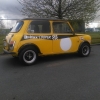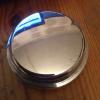
Torque Setting
#1

Posted 04 May 2012 - 08:32 PM
I've done mine to the pinned guide above which says 60lb but then reading the mini mag today and that says 150lb or 190lb for later types?
Obviously this significant difference has caused some concern.
I've got a 94 mini 35
#2

Posted 04 May 2012 - 09:29 PM
The latest Rover manual which I have says 260Nm, which is approximately 190 ft lbf, and of course to the next split pin hole. That is for disc brakes.
If you have discs, don't forget to nip up tightly (abou 50 ft lbf, not all the way) with the special washer before fitting the split cone and torquing up fully.
#3

Posted 04 May 2012 - 09:50 PM
#4

Posted 04 May 2012 - 10:02 PM
What issues is this likely to have caused?
It has had a knocking when going over bumps and a constant jerkiness. I've been on the motorway with it like this and it passed the mot on Tuesday, although granted this wouldn't have been something i would have expected them to pick up on.
Would it be possible for the drive shaft to be popping in and out?
And i don't know what you mean by your last paragraph, tighten up to 50lb with the washer and then split cone bit doesn't make sense to me.
And I've got discs and single split pin type.
#5

Posted 04 May 2012 - 10:06 PM
#6

Posted 04 May 2012 - 10:22 PM
#7

Posted 04 May 2012 - 10:24 PM
#8

Posted 04 May 2012 - 10:28 PM
Drive shaft nut (front hub, drum brakes). Continue tightening until next split pin slot aligns. Do not slacken off until the next slot aligns! 60 8.3
Fastener Torque (lbft) Torque (kgm)
Drive Shaft Nut. Continue tightening until next split pin slot aligns. Do not slacken off until the next slot aligns! 150 20.7
Actually, you're right it doesn't mention the difference between one and two hole CV joints. I think there is a different version in the FAQ, I'll look into the differences between the versions of the tables.
Edited by Dan, 04 May 2012 - 10:34 PM.
#9

Posted 04 May 2012 - 10:39 PM
#10

Posted 04 May 2012 - 10:47 PM
With the washer, tightening the nut pulls the shaft into the inner bearing, and then pushes the outer bearing up tight against the spacer, with no tendency to lock, as anything tapered will. Some people seem to regularly get away without it, others definitely do not. Make of that what you will, the difference is likely due to manufacturing tolerances, so if you don't do it you may or may not be one of those whose bearings fail prematurely.
Hub bearings are safety critical and my preference would always be to do them the official way.
#11

Posted 13 June 2016 - 08:06 PM
While you're all here : does anyone know the reason the later cv joints use a (much) higher torque figure?
I'd expect it to be the other way round (more initial torque for the multiple hole cv joint because you wont have to torque it much more to get to the next hole)
Cheers
Edit, mod could you move my comment to my post?
Edited by Dusky, 13 June 2016 - 09:00 PM.
#12

Posted 13 June 2016 - 08:51 PM
Got one on order :)
While you're all here : does anyone know the reason the later cv joints use a (much) higher torque figure?
I'd expect it to be the other way round (more initial torque for the multiple hole cv joint because you wont have to torque it much more to get to the next hole)
Cheers
Once at a higher torque figure any movement will give a correspondingly higher addition therefore 2 holes to avoid damage but to get it correctly tightened and so avoid bearing & CV fretting
1 user(s) are reading this topic
0 members, 1 guests, 0 anonymous users


















